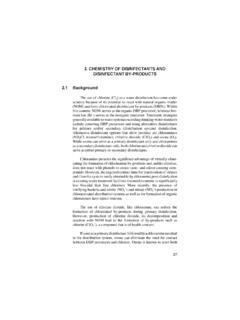Transcription of PEM & Alkaline Electrolyzers Bottom-up Manufacturing Cost ...
1 Austin Power Engineering LLC1 Cameron StWellesley, MA 2017 Austin Power Engineering LLCPEM & Alkaline Electrolyzers Bottom-up Manufacturing Cost Analysis Yong YangAustin PowerNovember 8, 2017 David HartE4tech12017 YY/DHWater electrolysis could play a significant role in the future energy system ..Introduction MarketOverviewRoadmap for electrolyser deployment by application. Source: 2014 FCH-JU study on water electrolysisConsolidated views on rollout potentialGermany is considering to support roll-out of ~1GW of electrolysers in the 2020ies timeframeMulti MW demo projects in industryA 2017 study commissioned by the FCHJU found that by 2025, an estimated cumulative electrolyser capacity of GW could be installed in Europe05001,0001,5002,0002,5003,00020102 015202020252030[EUR/kW] Capital cost for Alkaline systemsAlkaline (all data)Central caseRange05001,0001,5002,0002,5003,00020 102015202020252030[EUR/kW] Capital cost for PEM systemsPEM (all data)Central caseRange22017 if predicted cost reductions can be MarketOverviewData source cost reduction expectations.
2 2014 FCH-JU study on water electrolysisExpert predicted cost reductionsPrices of ~500 EUR/kW are now being quoted for 50MW+ systems(MW-scale)(MW-scale)Prices of <1,000 EUR/kW are now being quoted for multi MW systems, but price range remains wide across the industry32017 YY/DHToday s electrolyser market is comparatively small, the industry landscape is highly fragmented and no single design dominatesIntroduction Market Overview Perhaps 4% of global hydrogen supply is produced via electrolysis (incl. Chlor-Alkali) Larger (> 50 kW) water electrolysis systems are typically deployed for continuous operation. Examples are fertilisers and methanol production, fats & oils, float glass, .. The industry is highly fragmented, with a few established players and many start-ups / new entrants and cost reduction potential18%4%48%30%Coal gasification Electrolysis Natural gas reformingRefinery/Chemical off-gases18%4%48%30%Coal gasification Electrolysis Natural gas reformingRefinery/Chemical off-gasesSource: IEA (2007)18%4%48%30%Coal gasification Electrolysis Natural gas reformingRefinery/Chemical off-gases18%4%48%30%Coal gasification Electrolysis Natural gas reformingRefinery/Chemical off-gasesSource: IEA (2007)ChemistryManufacturing Capacity (MW/year)Revenue (million USD/year) Alkaline ~300 MW~100 PEM~ 50 MW~50 Total~350 MW~150 Rough estimates revenue varies year-on-year dependent on individual projects.
3 Current Manufacturing capacities are underutilised, but could be scaled up quickly if demand work with clients with various electrolysis technologies from the technology development stage to the large scale (GW) YY/DHTechnology DevelopmentTechnology in Early Commercial StageMature ProductsDemonstrationProjectsLarge Scale DeploymentPEMSOECA lkalineFutureAlkalineFuturePEMI ntroduction Our Clients5 Approach Manufacturing Cost Modeling MethodologyThis approach has been used successfully for estimating the cost of various technologies for commercial clients and the AssessmentManufacturing Cost ModelScenario AnalysesVerification & Validation Literature research Definition of system and component diagrams Size components Develop bill-of-materials (BOM)
4 Define system value chain Quote off-shelve parts and materials Select materials Develop processes Assembly Bottom-up cost model Develop baseline costs Technology scenarios Sensitivity analysis Economies of Scale Supply chain & Manufacturing system optimization Life cycle cost analysis Cost model internal verification reviews Discussion with technical developers Presentations to project and industrial partners Audition by independent of YY/DHAnode InkAnode SideCatalyst LayerMembraneProcessesCathode SideCatalyst LayerCathode InkHot PressLaminationPurchased GDLP urchased GDLPtPtNafion ,00020,00030,00040,00050,00060,00070,000 80,0003-Year TCO5-Year TCO10-Year TCO15-Year TCOT otal Cost of Owership ($)PEMFC Plug Hybrid Vehicle Full Battery Electric Vehicle6 Combining performance and cost model will easily generate cost results, even when varying the design YY/DHProcess SimulationEnergy requirementsEquipment size/ specsProduct CostsProduct cost (capital, O&M, etc.)
5 Conceptual DesignSystem layout and equipment requirementsCapital Cost EstimatesSite PlansSafety equipment, site prep, land costsHigh and low volume equipment costsAir (POX only)Nat. GasWaterFuelReformerPSAH2-rich gasH2-poor pure H2 LowPressureStorageMediumPressureStorageH ighPressureStorageFlowcntrlrFlowcntrlrFl owcntrlrDispenserTo VehicleCO2H2 OCompressor with intercoolersCoolingTowerProcess costMaterial costTape CastAnodePowder PrepVacuumPlasmaSprayElectrolyteSmall PowderPrepScreenPrintCathodeSmall PowderPrepSinter in Air1400 CSinter in AirFormingofInterconnectShearInterconnec tVacuumPlasmaSpraySlurrySprayScreenPrint Slurry SpraySlip CastFinish EdgesNote: Alternative production processes appear in gray to thebottom of actual production processes assumedBrazePaint BrazeontoInterconnectBlanking /SlicingQC LeakCheckInterconnectFabricationElectrol yteCathodeAnodeStack AssemblyFuel Station PerimeterElectrolyzer or SMR,High-PressureCompressorH2 High PressureCascade StorageSystemGaseous FuelDispensing IslandsUnderground Piping with shared conduitVentBuildingCovered Fueling IslandCNG High PressureCascade Storage SystemFire DetectorWalls with minimum fire rating of 2 hoursWall openings (doors & windows)
6 Building intake ventsAdjoining property that can be built onPublic sidewalks, parked vehiclesStreetsRailroad tracksOther flammable gas storage5 ft25 ft50 ft10 ft15 ft10 ft15 ft10 ftMinimum set-back distances for hydrogen and/or natural gasstorage (more stringent gas noted if relevant)Property of:TIAX LLC1061 De Anza , CA 95014 Task 5 CNG/Hydrogen FuelingSite Plan - Fueling StationHydrogen and CNG fueling stationSIZEDWG BYDWG NOREVAS tefan UnnaschB0228 - S00221 SCALE1" = 8 ft5 Jan 2004 SHEET1 OF 110 ftSecurity FenceNG line inft ft ft ft ft ft ft ftProcess Cost CalcsMaterialProcess$0$1$2$3$4$5$6$7$8$9 $10 LappingCMPWet thermal OxidationSpin CoatingWet Etching SiO2DC Sputtering NiRF Sputtering ESpin CoatingStepperDC Sputtering AgStrippingSpin CoatingStepperDry Etching SiO2 DRIE SiWet Etching SiO2 Dry Etching NIWafer Cost ($)Approach Manufacturing Cost Modeling Methodology010,00020,00030,00040,00050,0 0060,00070,00080,0003-Year TCO5-Year TCO10-Year TCO15-Year TCOT otal Cost of Owership ($)
7 PEMFC Plug Hybrid Vehicle Full Battery Electric Vehicle7 Austin Power Engineering s Manufacturing cost models can be used to determine a fully loaded selling price to consumers at high or low volumes. DirectLaborDirectMaterialsFactoryExpense GeneralExpenseSalesExpenseProfitConsumer Selling PriceFixed Costs Equipment and Plant Depreciation Tooling Amortization Equipment Maintenance Utilities Building Indirect Labor Cost of capital Overhead LaborVariable Costs Manufactured Materials Purchased Materials Fabrication Labor Assembly Labor Indirect MaterialsCorporate Expenses Research and Development Sales and Marketing General & Administration Warranty TaxesApproach Manufacturing Cost StructureManufacturing CostWe assume 100% financing with an annual discount rate of 10%, a 10-year equipment life, a 25-year building life.
8 And three months working YYThe hydrogen electrolysis system design is primarily driven by the output hydrogen flow rate, purity, and pressure Analysis82017 YY/DHStackPower SupplyDI Water O2/liquid SeparatorH2/liquid SeparatorKOH ScrubberH2 Boost CompressorDe-OxoH2 DryerStack CoolingH2 Pre-CoolerH2 After CoolerGeneric Hydrogen Electrolysis Plant Major ComponentsNot in PEM based system9 Different Alkaline system and stack designs can be tested in in different scenariosAlkaline System Stack Specifications2017 YY/DHAlkalineUnitCurrentFutureSystem size MW<120 MWGWS tack sizeNm3 ~1,50010,000 Stack power MW~6~50 System ~ ~ 30 System H2 purity% cell aream ~ 3~ 3 Cell densityA/cm ~ materialZirfontypeZirfontypeAnode / cathode materialNi, NiAl,Ni, NiAl, NiMoAl, etcCell frame materialCarbon steel with coatingCarbon steel with coating / NiBipolar plate materialNi coated carbon steelNi coated carbon steel / Ni10In Alkaline stacks, higher current densities are key to reducing costs.
9 But all options are subject to fundamental System Stack Cost Analysis2017 YY/DHCost contributorsPathways to cost reductionIdentified limitsMembrane and electrodesIncrease current density and reduce materials use through innovative componentdesign and advanced electrode materialsIndustry reports A/cm as a long term target. Limitation is acceptable efficiency at high currents. (Current density today typically: A/cm )Cell frameReduce material use through large cell conceptswith a better ratio between active area and frameareaMechanical stability of cell components, dependingon stack pressure levelCell frame materialReplace by (cheaper) injection moulded thermal plastic, though mechanical stability at pressure may be limitedMechanical stability of thermal plastic 11 Different PEM system and stack characteristics for current and future designs can be tested in in different scenariosPEM System Stack Specifications2017 YY/DHPEMUnitCurrentFutureSystem sizeMW<5 MWGWS tack size kW<5MW>10 MWSystem PressureBarg10~3010 ~30H2 Purity% areacm ~ > 1 Current densityA/cm 1 ~2> 2 Membrane materialNafion200 mNafion200 mCatalystIr, PtIr, PtCatalyst loadingmg/cm ~ 5< 1 Conductiveporous layerTi foamTi foamScreen pack platesTimeshFunctionreplaced by flow field platesBipolar plateTi foilTifoil.
10 Or SS316with Ti coatingCellframe materialTi or polymer basedPolymer based with metal inlay12 PEM cost reduction opportunities are strongly related to the reduced use of high price materials, though other components System Cost Analysis2017 YY/DHCost contributorsPathways to cost reductionIdentifiedlimitsComponents made of titanium (cell frame, screen pack, porous plate)Reduce use of titanium in bi-polar plates of steel plus titanium coating instead of full titanium. Increase current (high material and processing cost)expected to remain as the material of choice for acidic electrolysersElectrode catalystsMaterial changes using advanced catalyst support structures, mixed metal oxides and nano-structured metal costand catalyst activityfor acceptable efficiency.






